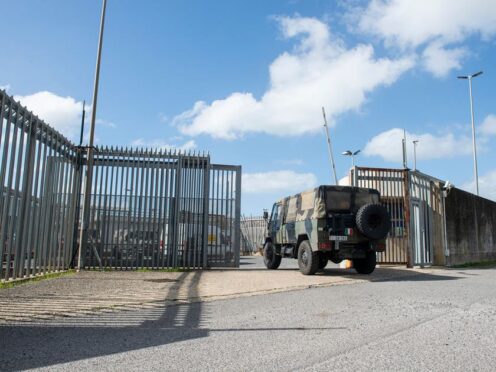
Pressure is building on authorities in Italy to close a Rome migrant detention centre where a 19-year-old Guinean allegedly hanged himself last month.
Visiting opposition senators have decried “undignified” conditions for people ordered to leave Italy but awaiting repatriation.
Italy’s 10 migrant repatriation centres have long been criticised by human rights groups.
They describe them as black holes of human rights violations where undocumented migrants are essentially detained for months without charges in conditions worse than prisons.
The centres are supposed to be temporary holding facilities for migrants whose asylum bids failed, or foreigners who have been ordered expelled for criminal or other reasons while the paperwork is completed to send them home.
But because of bureaucratic delays and a lack of repatriation agreements with countries of origin, only around half of the detainees are actually sent back and the centres end up acting as de facto prisons but without a prison’s rehabilitation, educational or proper medical facilities, rights groups say.

The right-wing government of premier Giorgia Meloni has defended the use of the centres and even called to expand them as a necessary component of a broader strategy to manage Italy’s migration flows.
Her government has extended the amount of time migrants can be held to 18 months as part of a deterrent strategy to persuade would-be refugees and their traffickers to stay home.
The Radicali Roma, an association affiliated with the Italian Radical Party, started an online petition on Friday calling on centre-left Mayor Roberto Gualtieri to close Rome’s repatriation centre in Ponte Galeria, citing repeated episodes of violence, suicide and protests by desperate detainees.
Last month, the body of Ousmane Sylla was found in the centre after he apparently hung himself.
He had been ordered expelled from the country, but Italy has no repatriation agreement with his native Guinea.
After his body was discovered, detainees set mattresses on fire and threw objects at law enforcement personnel, resulting in 14 arrests.
The centre has a maximum capacity of 125 people.
In recent days, another six migrants attempted to kill themselves at the same facility, said Marco Stufano, the head of the office of Rome’s prefect.
One remained in hospital, two were returned to the centre and three were transferred to other facilities because their conditions were deemed “incompatible” with detention at Ponte Galeria, he said.
Last month, Rome’s city assembly called on Mr Gualtieri to open “urgent” negotiations with government authorities to close the Ponte Galeria, given the “serious violations of human rights suffered by people detained there.”
Even Italy’s national guarantor for the rights of prisoners, Mauro Palma, weighed in after visiting the centre in December.

In letters to Rome’s prefect and police chief, Mr Palma decried the lack of monitoring at the centre, saying any facility that deprives people of their freedom must have a functioning system of registering critical events and medical interventions for violence that results in injury, riots and attempted escapes to ensure the basic rights of detainees are being respected.
This week, three opposition senators visited the centre and emerged stunned by what they saw.
“This place is worse than a penitentiary,” said Senator Ivan Scalfarotto, of the Italy Alive party.
“The rooms where they live are absolutely unwatchable, toilets are below any human standard.
“Inside this place people do nothing all day, there is no labour, training, no education, something that is normally provided in all our penitentiaries.
“People are kept here without any hope.”
Senator Walter Verini, with the opposition Democratic Party, said while criticism of the centers had been continuous for years, the government’s new provisions allowing for detention of up to 18 months required immediate action.
“We have to fight because this is something unworthy of a civilised and democratic country,” he said.
Interior minister Matteo Piatedosi has described the expansion of the network of repatriation centres as a “fundamental” element in the government’s overall migration strategy, and said the difficult conditions found in them are the result of riots and vandalism by the detainees.
At a recent press briefing, he said 50% of the detainees are repatriated, that there had been an increase of 20%-30% in repatriations so far this year compared to the previous year, and that he expected the numbers to grow.
But the actual number of repatriations is among the lowest in Europe, with an average of 3,000 people sent back every year out of more than 150,000 arrivals in 2023 and more than 105,000 in 2022.
“There is no prospective to deny any human rights, but in these centres are people who – after a long process of checks of irregularity in their residency permits — present conditions of danger that are confirmed by judicial authorities,” he said.

Enjoy the convenience of having The Sunday Post delivered as a digital ePaper straight to your smartphone, tablet or computer.
Subscribe for only £5.49 a month and enjoy all the benefits of the printed paper as a digital replica.
Subscribe